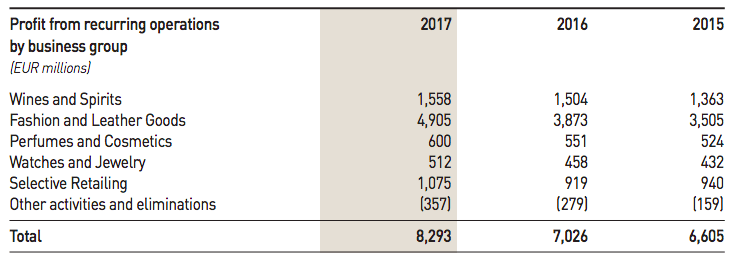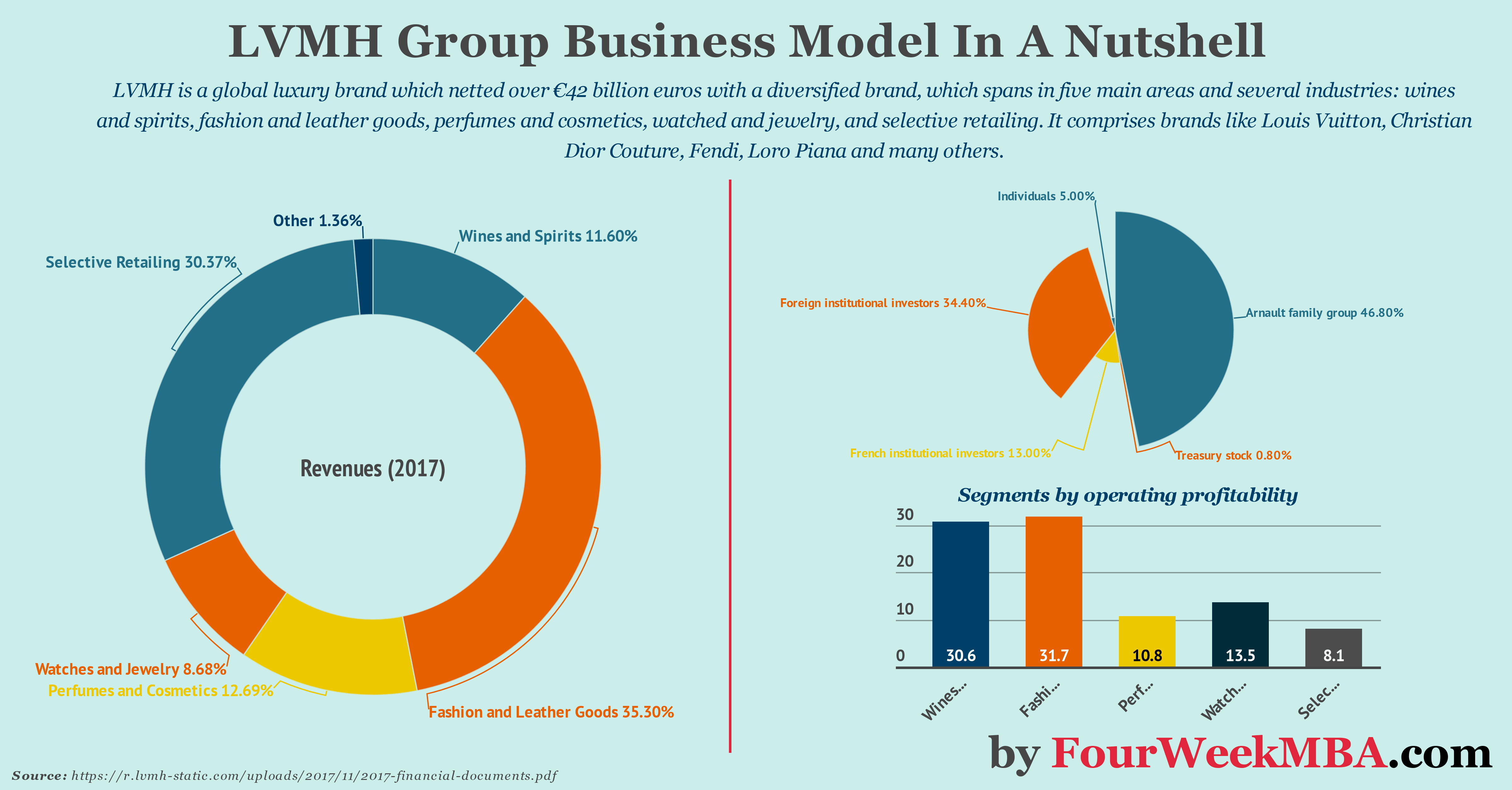| Not logged in : Login |
About: Bernard Arnault Empire: LVMH Group Business Model In A Nutshell Goto Sponge NotDistinct Permalink

LVMH is a global luxury brand which netted over €42 billion euros with a diversified brand, which spans in five main areas and several industries: wines and spirits, fashion and leather goods, perfumes and cosmetics, watched and jewelry, and selective retailing. It comprises brands like Louis Vuitton, Christian Dior Couture, Fendi, Loro Piana, and many others. It all started when the young Bernard joined the father's company, which primarily focused on construction. Yet when Bernard Arnault joined the company in 1971, the company began to focus on real estate. Ever since Bernard Arnault grew to become CEO and then drove the father's company through a series of deals that brought to the creation of LVMH. Today LVM is the largest luxury empire on the globe. Comprising brands like Fendi, Luis Vuitton, and many others. LVMH mission around three pillars As clarified on its code of conduct the mission of the company can be summarized in three fundamental values: Be creative and innovative: creativity and innovation are part of our DNA. Over the years, they have ensured our Maisons’ success and established their legitimacy. This combination of creativity and innovation is the foundation of our Maisons and figures at the heart of the delicate balance required to continually renew our offering while resolutely looking to the future, always respecting our unique heritage; Deliver excellence: because LVMH embodies the world of craftsmanship in its most noble and most accomplished form, we pay meticulous attention to detail and to perfection. We never compromise on quality. From products to service, we cultivate our difference through this constant quest for excellence; Cultivate an entrepreneurial spirit: LVMH has an agile and decentralized organization that encourages efficiency and responsiveness. It stimulates individual initiative by entrusting each person with meaningful responsibilities. Our entrepreneurial spirit encourages both risk-taking and perseverance. It requires pragmatic thinking and an ability to motivate teams, leading them to achieve ambitious objectives. LVHM Ethical Principles For a large group that has been able to scale up by keeping its brands highly profitable, setting up ethical principles might be as important as setting up financial metrics. In fact, when it comes to the luxury industry, the strength of the brand plays a key role. However, it is critical to making the brand grow together with a strong foundation. In the case of LVMH, this foundation is represented in its code of conduct as a set of principles Acting responsibly and with social awareness Providing a fulfilling work environment and valuing talent Commitment to protecting the environment Winning the trust of customers Winning the confidence of shareholders Acting with and commitment to integrity in the conduct of business Around those seven principles, a set of actions are developed and assessed to keep those principles as the guidelines for the company's ethical growth. Who owns LVMH? The Arnault Family has managed to Source: LVMH Letters to Shareholders LVMH business model: an ecosystem of Maisons independently managed Source: LVMH Annual report for 2017 When you think of LVMH the brands that comprise the name (Louis Vuitton, Moet Hennessy). However, LVMH group is a galaxy of luxury brands and Maisons, acquired throughout the years by the development and growth campaign of Bernard Arnault. Although those Maisons are part of an ecosystem, they are also autonomously run. Thus, each of those Maisons is based on a business model which is unique to the brand. This kind of organization based on decentralized operations makes the brands part of the LVMH galaxy agile. So that each brand can be connected to its customers, can make decisions fast and still allow its employees to have an entrepreneurial mindset. In terms of operations the company comprises five main segments: Wines and spirits Fashion and leather goods Perfumes and cosmetics Watches and jewelry And selective retailing Wines and Spirits In terms of profits breakdown the wines and spirits segment is among the most profitable. As shown on LVMG annual report: Wines and Spirits profit was 1,558 million euros Champagne and wines contributed 674 million euros While cognacs and spirits accounted for 884 million euros What brands are part of the wines and spirits? Moët & Chandon: with products like Moët Impérial, Ice Impérial, Nectar Impérial Rosé Grand Vintage 2009 Dom Pérignon: with products like Dom Pérignon Rosé 2005 and Dom Pérignon Blanc 2009, Dom Pérignon P2 2000 (Second Plénitude) Mercier as accessible prestige champagnes Ruinart value proposition is built on premium cuvées Veuve Clicquot with products like Brut Carte Jaune and Brut Rosé Krug with products like the iconic Grande Cuvée Estates & Wines with products like the creation of the Termanthia Barrel in partnership with Loewe. Chandon with products like Chandon Me and Chandon S Orange Bitters Hennessy which is an important part of the wines and spirits segment Glenmorangie and Ardbeg a malt whisky, with products like Glenmorangie Bacalta and Ardbeg An Oa Belvedere highlights the importance of vodka’s place of origin Volcán de Mi Tierra tequila launched in the United States and Mexico Fashion and Leather Goods This segment includes fashion luxury brands such as Christian Dior Couture, Rimowa, Louis Vuitton, Kenzo, Givenchy, Loro Piana, and Fendi. The business group’s operating margin as a percentage of revenue represented the 31.7%. Together with the wines and spirits that is the most profitable segment. It comprises luxury brands like: Louis Vuitton Christian Dior Couture Fendi Loro Piana Céline Kenzo Loewe Givenchy Berluti Marc Jacobs Perfumes and Cosmetics Perfumes and Cosmetics contributed to 600 million euros, to the overall company's net profits. This growth came from Parfums Christian Dior, Kendo, and Parfums Givenchy. It comprises brands like: Parfums Christian Dior Guerlain Parfums Givenchy Kenzo Parfums Benefit Cosmetics Maison Francis Kurkdjian Watches and Jewelry The Watches and Jewelry contributed 512 million euros in profits. With brands like Bvlgari and Hublot, this is a critical part of the overall group. It also has a profit margin of 13.5%. Within this segment there are several brands: Bvlgari Hublot Zenith Chaumet Fred De Beers Selective Retailing Selective Retailing Profit from Selective Retailing was 1,075 million euros. Within this segments there are brands like: Sephora Le Bon Marché DFS Starboard Cruise Services What is the most profitable segment? Source: LVMH Annual Report 2017 With a 31.7% in operating margin for 2017, Fashion and Leather Goods is the most profitable part of the business. Followed by wines and spirits with the 30.6% operating margin and Watches and Jewelry with 13.5% in operating margin. The remaining are Perfumes and Cosmetics with a 10.8% and Selective Retailing with an 8.1% in operating margins. Where does LVMH make more money? Source: LVMH Annual Report 2017 France remains the most significant country and the market for LVMH. As the country where LVMH has its home, France also represents an important market for the company, which keeps generating 10% of its revenues. Other markets like the United States and Japan are pretty important too. Source: LVMH Annual Report 2017 France is also the country where most of LVMH stores are located. Even though way smaller than the US market, France counts about 508 stores. The luxury empire with agile distribution and decentralized management One of the critical ingredients of LVMH success is based on its ability to let the Maisons be rung separately while the operations of each are kept agile. This allows the company to be quick at understanding the customers. Also, each mature brand will be used as a cash cow to finance the development of new and less mature brands. Handpicked related content: https://fourweekmba.com/what-is-a-business-model/ How Does PayPal Make Money? The PayPal Mafia Business Model Explained How Does WhatsApp Make Money? WhatsApp Business Model Explained How Does Google Make Money? It’s Not Just Advertising! How Does Facebook Make Money? Facebook Hidden Revenue Business Model Explained Marketing vs. Sales: How to Use Sales Processes to Grow Your Business The Google of China: Baidu Business Model In A Nutshell Accenture Business Model In A Nutshell Salesforce: The Multi-Billion Dollar Subscription-Based CRM How Does Twitter Make Money? Twitter Business Model In A Nutshell How Does DuckDuckGo Make Money? DuckDuckGo Business Model Explained How Amazon Makes Money: Amazon Business Model in a Nutshell How Does Netflix Make Money? Netflix Business Model Explained
| Attributes | Values |
|---|---|
| type | |
| label |
|
| label |
|
| sameAs | |
| Description |
|
| depiction | |
| name |
|
| url | |
| legalName |
|
| http://www.w3.org/2007/ont/link#uri | |
| is Relation of |
Alternative Linked Data Documents: PivotViewer | iSPARQL | ODE Content Formats:
![[cxml]](/fct/images/cxml_doc.png)
![[csv]](/fct/images/csv_doc.png) RDF
RDF
![[text]](/fct/images/ntriples_doc.png)
![[turtle]](/fct/images/n3turtle_doc.png)
![[ld+json]](/fct/images/jsonld_doc.png)
![[rdf+json]](/fct/images/json_doc.png)
![[rdf+xml]](/fct/images/xml_doc.png) ODATA
ODATA
![[atom+xml]](/fct/images/atom_doc.png)
![[odata+json]](/fct/images/json_doc.png) Microdata
Microdata
![[microdata+json]](/fct/images/json_doc.png)
![[html]](/fct/images/html_doc.png) About
About


![[RDF Data]](/fct/images/sw-rdf-blue.png)
OpenLink Virtuoso version 08.03.3330 as of Mar 11 2024, on Linux (x86_64-generic-linux-glibc25), Single-Server Edition (7 GB total memory, 6 GB memory in use)
Data on this page belongs to its respective rights holders.
Virtuoso Faceted Browser Copyright © 2009-2024 OpenLink Software







